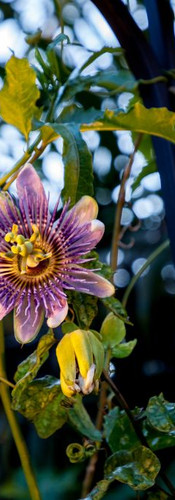New This Week
April 14, 2025

Plant This Not That!
Chinese Wisteria and Japanese Wisteria Alternatives
Who doesn’t absolutely love a gorgeous spring bloom? At the end of a long cold winter, the sight of a full and fragrant cluster of blooms is like coming up for air. This time of year, you may be finding yourself admiring those groupings of spring blooming vines with all the pendulous purple flowers. Wisteria is so lovely!
But did you know that most wisteria you see is non-native? Read more about why we should consider alternatives and then find a great list of substitutes below.
Both Chinese wisteria (Wisteria sinensis) and Japanese wisteria (Wisteria floribunda) were introduced to the U.S. in the 1800s as a favored plant for climbing trellises, gazebos, and porches. It provided dense shade and was exceptionally fast growing. "We" thought this was a darling option! Unfortunately the collective "Past Us” was not doing a favor for “Future Us.” We know better now!
These non-native wisteria are now considered invasive in at least 19 states. Both are aggressive vines that can reach up to 70 feet with 15 inch stems (or more)! These invasive vines can easily choke or kill native trees by shading out foliage and girding tree trunks. Understory plants and shrubs are smothered or killed beneath the heavy weight or shaded out completely. And these non-native wisterias often outcompete native plants for resources in North Carolina, most commonly in disturbed areas like forest edges. They easily spread by runners and seeds so even with our best intentions, they are incredibly hard to contain. Plus horror stories abound of smashed gutters, split siding, and even structural/foundation issues. The collective present-day "Us” might be looking for less costly and more beneficial alternatives!
Fortunately, we have plentiful, gorgeous alternatives! Check out these native perennial vines at Painters this spring:
Passiflora incarnata Passionflower vine
NATIVE perennial vine (z5-9) full sun-part shade, climbing 6-8'
Utterly extraordinary spring blooms, plus edible fruits, known as maypops
Thrives in well-drained soil, drought tolerant; spreads by root suckers
Important larval host plant with exceptional wildlife value, as beneficial as it is beautiful
Bignonia capreolata Crossvine ‘Tangerine Beauty’
NATIVAR perennial vine (z5-9) full-part sun, up to 30' climb
Abundant long-lasting tangerine blooms bring hummingbirds galore
Easily attaches to most surfaces by tendrils
Tolerates partial shade, but best flower production occurs in full sun
Campsis radicans Trumpet vine ‘Flava’
NATIVAR perennial vine (z4-10) full sun-part shade, 30-40' climb
Attractive orange-yellow summer blooms, adored by hummingbirds
Needs a sturdy structure for support; an aggressive spreader, best kept contained
Can cause skin irritation on contact; aka cow-itch
An aggressive spreader, best kept contained; can cause skin irritation (aka cow-itch)
Gelsemium sempervirens Carolina jessamine
NATIVE perennial vine (z6-10) full-part sun, 10-20' climb, 4-8' wide
Masses of yellow flowers in early spring, adored by hummingbirds
Semi-evergreen foliage takes on a burgundy tinge in cool weather
Happily grows up trellises or arbors; planter beware: highly toxic if ingested
Lonicera sempervirens Coral honeysuckle
NATIVE perennial vine (z4-9) full sun, 15-25' climb
Coral red-yellow trumpet blooms spring to fall, semi-evergreen
Blooms bring pollinators, fall berries attract birds
A lovely native alternative to more aggressive honeysuckle vines, adored by hummingbirds!
Lonicera sempervirens Coral honeysuckle ‘Magnifica’
NATIVAR semi-evergreen vine (z4-8) full-part sun, 7-10' climb
Sweetly scented, bright orange, tubular blooms; after flowering, red fruits provide food for birds
Twines beautifully up trellises or other support; a favorite of hummingbirds!
Lonicera sempervirens Coral honeysuckle ‘Major Wheeler’
NATIVAR deciduous perennial vine (z4-8) full sun, climbing up to 10'
Abundant red trumpet flowers spring-fall; valuable for wildlife, hummingbird magnet!
Needs support to climb; not invasive and easy to grow, amenable to pruning
Not invasive and easy to grow; beautiful and highly valuable for wildlife
In previous seasons, Painters has carried American wisteria (specifically, Wisteria frutescens 'Amethyst Falls') and hope to again soon. The native species is not only a nectar source for butterflies and native insects, but it is also the larval host for silver-spotted skipper butterflies. A solid alternative choice!
.png)









